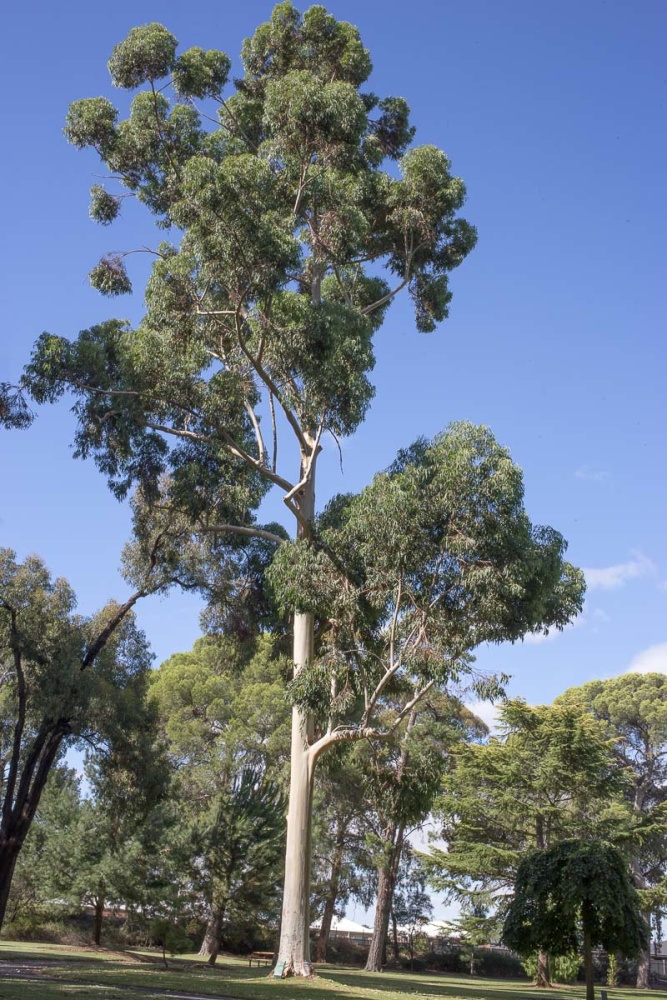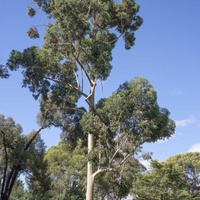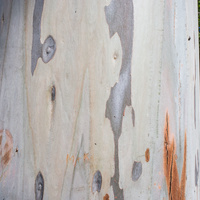Common name: Blue gum
Other common names: Sydney blue gum, Willow leaf gum
Description
Blue Gum or Sydney Blue Gum is an Australian eucalypt valued for its wood and for the honey derived from its flowers.
Its natural range is limited to eastern Australia, to areas near the coast extending from southern New South Wales to Maryborough in South-East Queensland.
It is fast-growing and, on favourable sites, may become a large tree, attaining heights of 35 to 80 m (115 to 260 ft) with a trunk diameter of up to 2 m (6.5 ft). The trunk is usually straight, of good form, and in forest environments, clear of branches for most of the tree height, supporting a narrow, moderately leafy crown of ascending branches.
On open sites, trees are typically 15 to 25 m (50 to 82 ft) tall with a large, wide-spreading, rounded crown. The bark is grey, thin and smooth, with age becoming grey-brown, thick, rough and furrowed. It persists on the lower part of the trunk but higher up peels and exfoliates, revealing smooth blue-grey to white underbark.
The adult leaves are lance-shaped, tapering to a fine point, 10 to 20 cm (4 to 8 in) long, dark glossy green on top, paler underneath, and remain on the tree in all seasons.
Typical of other eucalypts, the flowers are small with long white filaments. They bloom from spring to autumn, borne in clusters of four to ten at the sides of the branches. Fertilised flowers develop into small, green, cup-shaped seed capsules, which become dry, woody and brown when mature with small cubed or oval-shaped seed inside.

Bendigo Botanic Gardens, Victoria, Australia
Use
Blue gum is cultivated in its native Australia and countries in Africa, the Americas, Asia and the Pacific, mainly for its timber.
It is a tough, hard and heavy wood in the 700 to 1000 kgs per cubic meter (44 to 62 lbs per cubic ft) range and has moderate natural resistance to rot, decay and wood-boring insects. This puts it in the durable hardwood class, suitable for indoor and outdoor construction. The sapwood is pale brown and distinct from the heartwood, which is pink to dark red, becoming darker over time and with attractive figuring, usually with kino (gum) veining.
Well-formed logs are sawn into beams and planks used in general construction, mainly boat-building, flooring, cladding, panelling, furniture and cabinets, and for making boxes and crates. Small-diameter logs are cut for utility poles, as well as for converting into plywood and particleboard. It is an excellent fuelwood and is cultivated in plantations in Brazil for use in steel-making.
Blue Gum is long introduced in Brazil and is considered a major honey tree there, with nectar flows peaking around every two years. At peak flows, honey yields may be up to 100 kgs (220 lbs) per colony per season. The honey is dark amber, strongly flavoured and granulates fairly quickly to a soft, smooth grain. The flowers are also a valuable source of pollen for brood-rearing honeybees.
General interest
A Sydney blue gum planted in 1906 in the Woodbush Forest Reserve in Limpopo Province, South Africa, is reportedly that country’s tallest tree at 81 meters (266 ft).
Climate
Grows naturally in sub-humid to humid subtropical and tropical mid-elevation climates, generally areas with annual lows of 7 to 19°C, annual highs of 18 to 32°C, annual rainfall of 600 to 2500 mm and a dry season of 7 months or less. However, it reaches its best development as a timber tree in areas with annual rainfall of 900 mm or more.
Growing
New plants commonly start from seed, which remain viable for several years while stored under cold, dry, air-tight conditions. The seed need no pre-treatment and can be sown directly in containers with a free-draining potting mix. Most germinate within ten to twenty days, after which the seedlings are cared for in a nursery until they are of a plantable size, when about four to six months old.
Blue Gum trees perform best on free-draining clay-loam, loam, silt-loam and sandy-loam soils of a moderately acid to neutral nature, generally with a pH of 5.5 to 7.5, and on sites with full sun exposure. It has poor tolerance to slow-draining, waterlogged or saline soils.
Problem features
Blue Gum is assessed as a high weed risk species for Hawaii and Florida, respectively, by the Hawaii Pacific Weed Risk Assessment (HPWRA) project and the IFAS Assessment of Non-Native Plants in Florida's Natural Areas.
Where it grows
References
Books
-
Berni, C. A & Bolza, E. & Christensen, F. J. 1979, South American timbers - the characteristics, properties and uses of 190 species, Commonwealth Scientific and Industrial Research Organization (CSIRO), Division of Building Research, Highett, Victoria, Australia
-
Boland, D. & Brooker, I. & McDonald, M. W. 2006, Forest trees of Australia, 5th ed., CSIRO Publishing (Ensis), Melbourne
-
Burns R.M., Mosquera M.S. & Whitmone J.L. 1998, Useful trees of the tropical region of North America, North American Forestry Commission Publication (Number 3), Washington D.C.
-
C.A.B. International 2013, The CABI encyclopedia of forest trees, CABI Publishing, Wallingford, Oxfordshire
-
Clarke, B. & McLeod, I. & Vercoe, T. 2009, Trees for farm Forestry : 22 Promising Species, Rural Industries Research and Development Corporation (RIRDC), Wagga Wagga, New South Wales
-
Clemson, A. 1985, Honey and pollen flora, New South Wales Department of Agriculture, Inkata Press, Melbourne
-
Crane, E., Walker, P. & Day, R. 1984, Directory of important world honey sources, International Bee Research Association, London
-
Jex-Blake, A. J. 1957, Gardening in East Africa : a practical handbook, 4th ed., Royal Kenya Horticultural Society, Longmans, Green and Company, London
-
Little, E. L. & Skolmen, R. G. 1989, Common forest trees of Hawaii (native and introduced), Agricultuural Handbook No. 679, Forest Service, U.S. Department of Agriculture, Washington, D.C.
-
Little, E.L. Jr. 1983, Common fuelwood crops: a handbook for their identification, McClain Printing Company, Parsons, West Virginia
-
Porter, T. 2012, Wood : identification & use, Compact edition, Guild of Master Craftsman Publications, Lewes, East Sussex
-
Randall, R. P. 2002, A global compendium of weeds, R.G. and F.J. Richardson Press, Melbourne
-
Randall, R. P. 2007, The introduced flora of Australia and its weed status, Cooperative Research Centre for Australian Weed Management, Glen Osmond, South Australia
-
Scheffer, T. C & Morrell, J. J. 1998, Natural durability of wood : a worldwide checklist of species, Forest Research Laboratory, Oregon State University, Corvallis, Oregon
-
Troup, R.S. & Joshi, H. B. 1975 to 1981, Silviculture of Indian Trees (3 volumes), Government of India Publications, New Delhi
-
Webb, D. B. 1984, A Guide to species selection for tropical and sub-tropical plantations, 2nd ed., Unit of Tropical Silviculture, Commonwealth Forestry Institute, University of Oxford, Oxfordshire
Articles, Journals, Reports and Working Papers
-
Skolmen R.G. 2000, Some woods of Hawaii: properties and uses of 16 commercial species, University of Hawaii, Honolulu, (Resource Managment; RM-7), 33 p.



